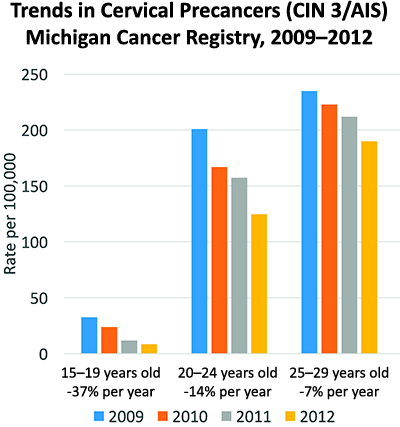HPV Vaccines and Cervical Precancers

The cervix is the lower, narrow end of the uterus. The uterus—also known as the womb—is where a baby grows when a woman is pregnant. A cervical precancer is a serious spot on the cervix (doctors call it CIN 3 / AIS) that can turn into cancer if it is not found early and treated.
Human papillomavirus (HPV) a group of more than 150 related viruses. Some types of HPV can cause warts, and other HPV types can lead to cancer.
In 2006, a vaccine became available in the United States that can protect against the types of HPV that most commonly cause cervical cancer. The vaccines are recommended for boys and girls starting at age 11 to 12 years.
How the Study Worked
To understand the impact of HPV vaccines on cervical precancers, CDC scientists set up systems with four cancer registries (Kentucky, Louisiana, Michigan, and Los Angeles). These registries collected information on how many women got cervical precancers. Scientists used this information to find out—
- If the rates of women getting cervical precancers went up, went down, or stayed the same.
- How the rates of women getting cervical precancers compared with the rates of women getting cervical cancer.
- How these rates changed in Michigan, the only registry with four complete years of data (2009 to 2012).
What the Study Found
- The average age for women to get cervical precancers was 30 years old.
- The average age for women to get cervical cancer was 49 years old.
- On average, six cases of cervical precancers were diagnosed for every case of cervical cancer.
- Women got cervical precancers at different rates in the four areas studied. The rate was lowest in Los Angeles (19 per 100,000 women) and highest in Kentucky (70 per 100,000 women).
- In Michigan, the rate of women who were diagnosed with cervical precancers—
- Went down 37% each year among girls and women who were 15 to 19 years old.
- Went down 14% each year among women who were 20 to 24 years old.
- Went down 7% each year among women who were 25 to 29 years old.
What This Means
The rate of women who were diagnosed with cervical precancers went down among girls and women who were 15 to 29 years old in Michigan. This was likely related to—
- Changes in the recommended age to start getting Pap tests (from 18 to 21), and how often to get Pap tests (from annually to once every three years).
- Girls being vaccinated against human papillomavirus (HPV), a common virus that can cause cervical cancer. HPV vaccines became available in the United States in 2006.
The wide differences in rates of women who were diagnosed with cervical precancers in the four areas studied may be related to—
- How many doctors followed current cervical cancer screening recommendations.
- How many women were vaccinated against HPV.
- How many women did other things that could raise their cervical cancer risk, like smoking cigarettes or having many sexual partners.
Citation
Watson M, Soman A, Flagg EW, Unger E, Deapen D, Chen VW, Peres LC, Copeland G, Tucker TC, Garnett E, Saraiya M. Surveillance of high-grade cervical cancer precursors (CIN III/AIS) in four population-based cancer registries, United States, 2009–2012. Preventive Medicine 2017;103:60–65.
- Page last reviewed: March 21, 2018
- Page last updated: March 21, 2018
- Content source:
- Maintained By:


 ShareCompartir
ShareCompartir